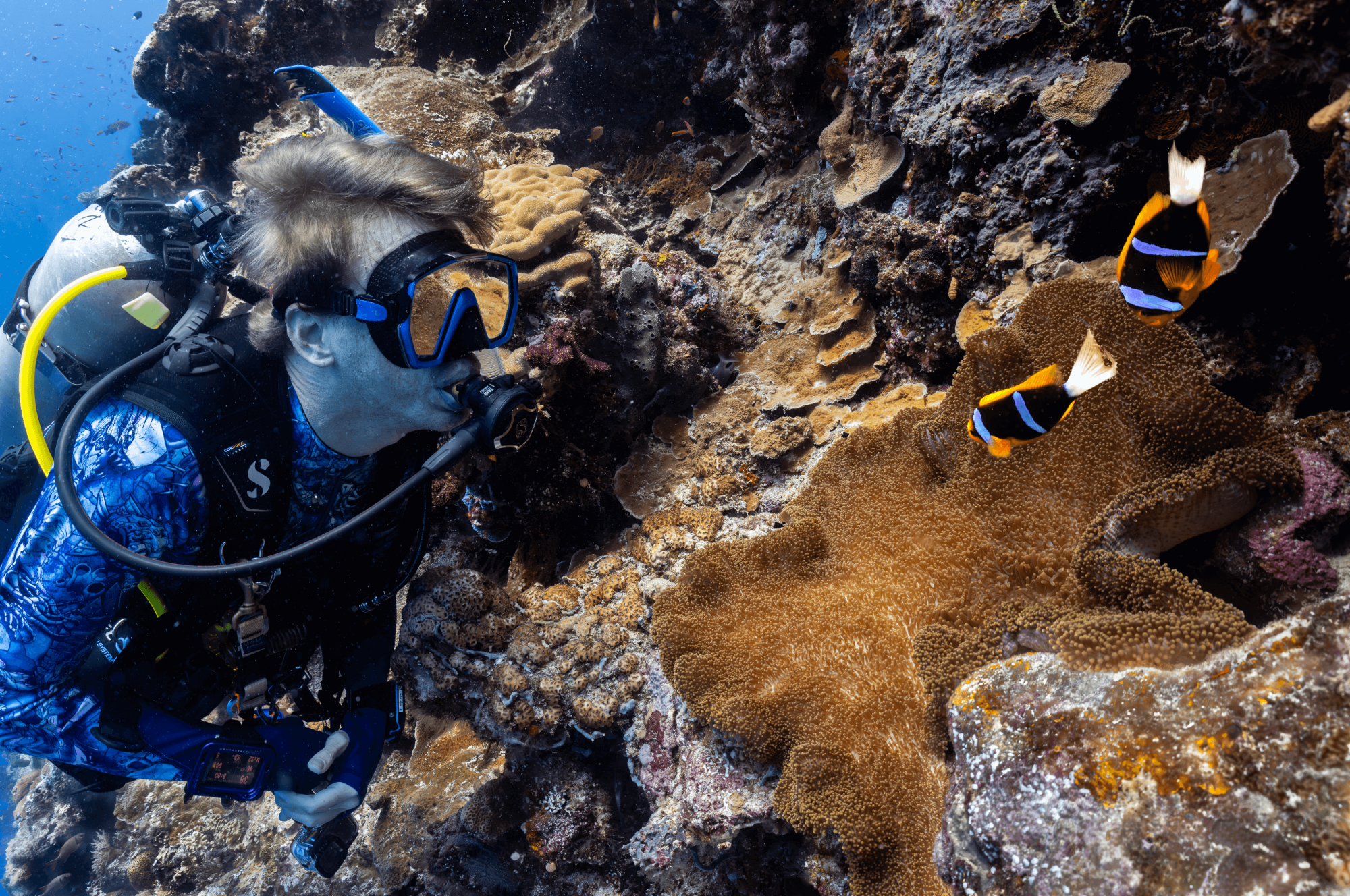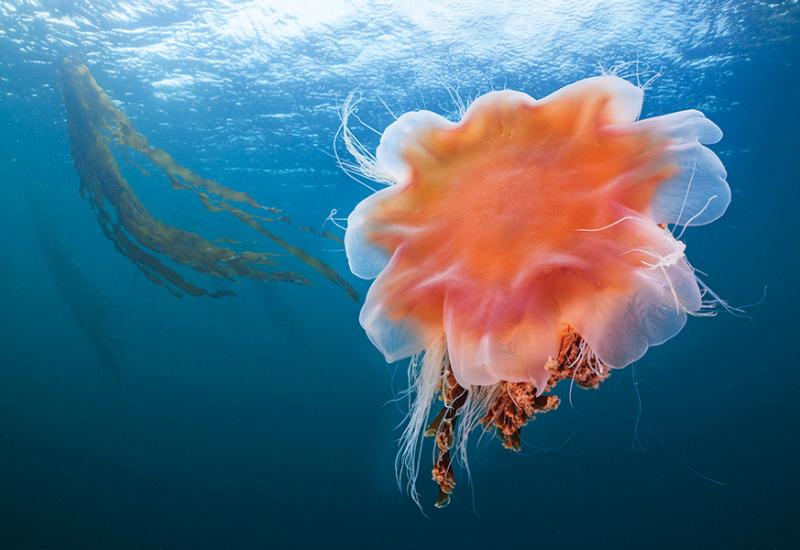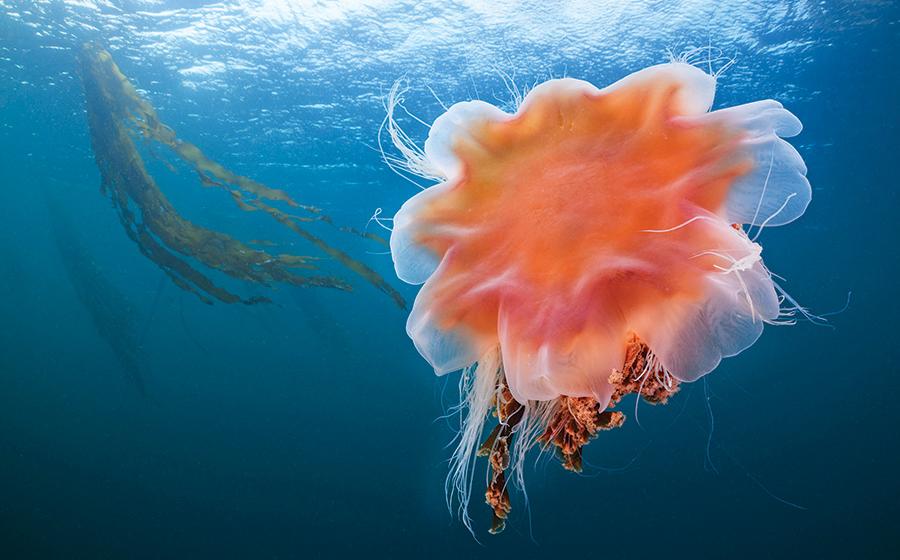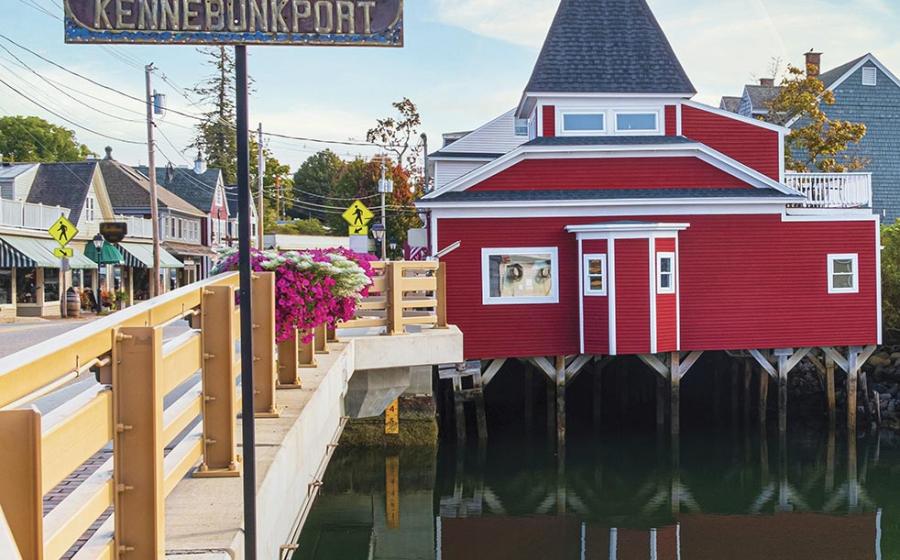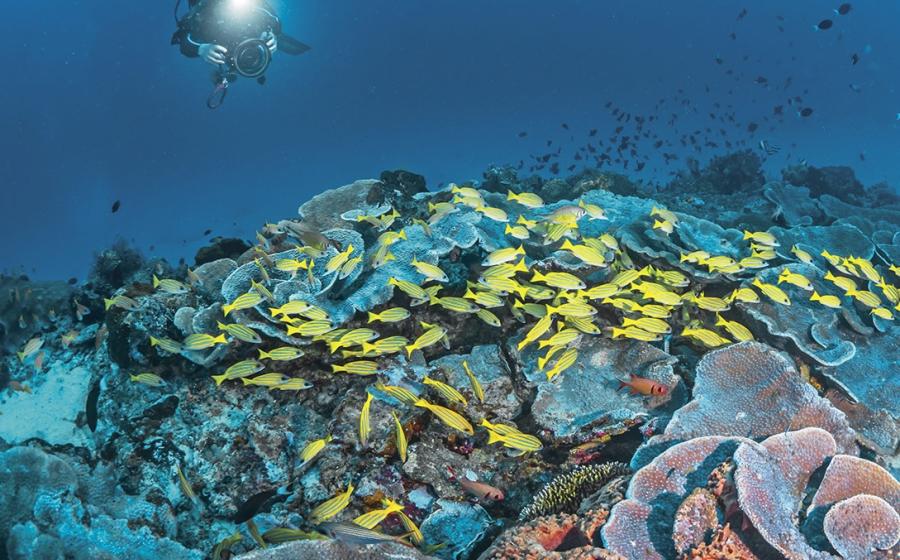How a Liveaboard Became Our New Holiday Tradition

Candice LandauStephen inspects a small fish inside a coral head in Palau.
I’m 40 feet below the surface when my heartbeat starts to throb in my throat. Though the water is velvet black and clings to me like a rash guard, it isn’t the darkness that leaves a metallic tang on my tongue. It isn’t even that I’m at the back of our small group, a reef shark gliding in and out of my periphery like a leopard in the shadows.
Instead, my inability to settle and focus has everything to do with the cone of light in front of me and the myriad life it reveals. Tonight I have traded my strobes for a single Kraken video light. It sits atop my camera housing like a lighthouse, its white beam shattering the dark to illuminate sea slugs that look like lettuce leaves, a rose-colored juvenile scallop frantically waving its opaque tentacles, crinoid shrimp on feather stars, and tiny larval fish that dart in and out of my light beam to feed on plankton.
Related Reading: How to Pack for a Liveaboard Dive Trip
Palau has stunned me. I expected healthy reefs and plenty of sharks but not walls bursting to life like forests from Avatar. Rocks bloom with anemones and anemonefish. Endless purple anthias and bug-eyed cardinalfish obscure the smaller corals, and sea fans the color of blood orange rind weave complex nets between it all.
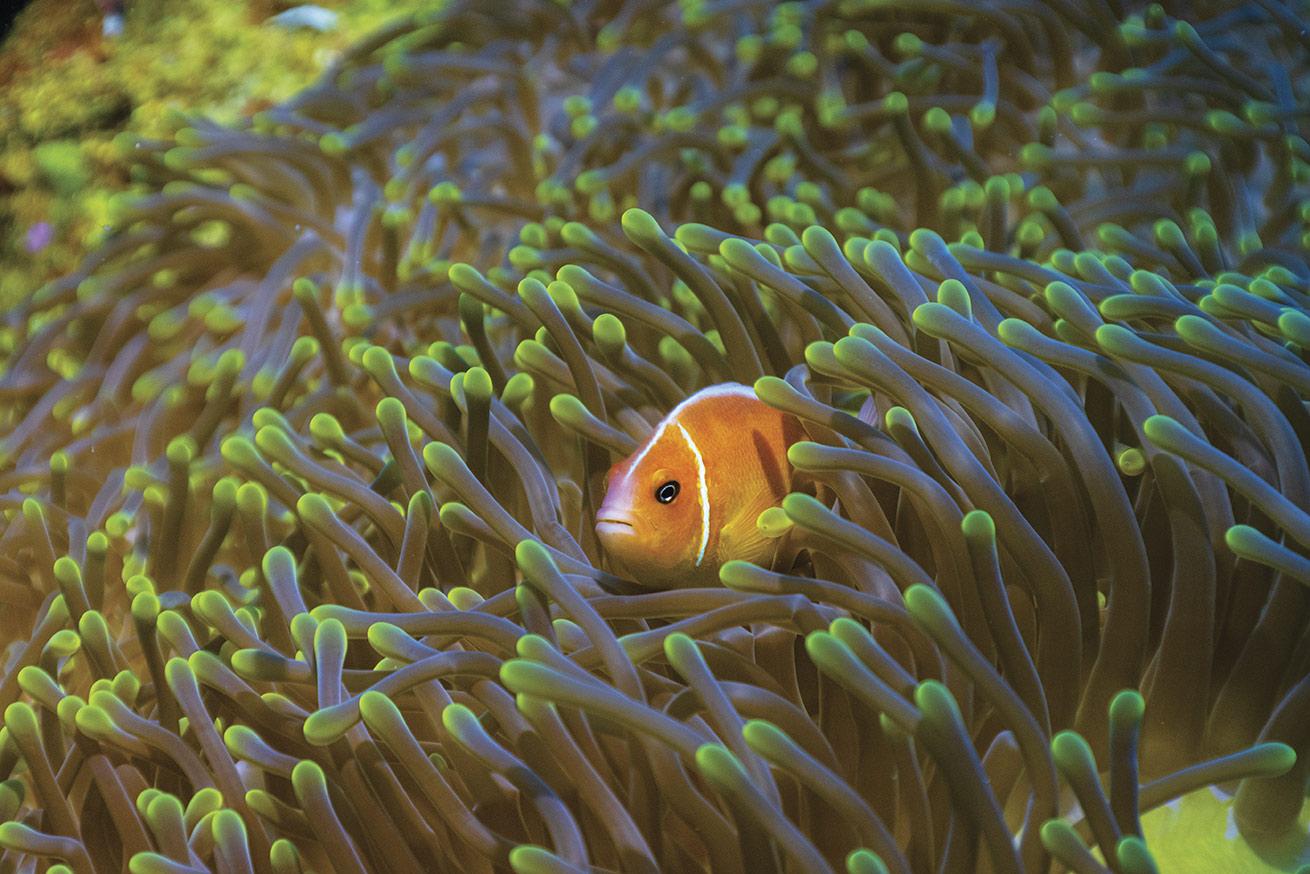
Candice LandauAn anemone fish preens inside an anemone.
At the end of each dive, I pick up the planner I created for writing assignments, and in the “Emotional State” section, I jot down variations of the word happy: “content, calm, thrilled, can’t stop smiling!”
Night dives need a different word.
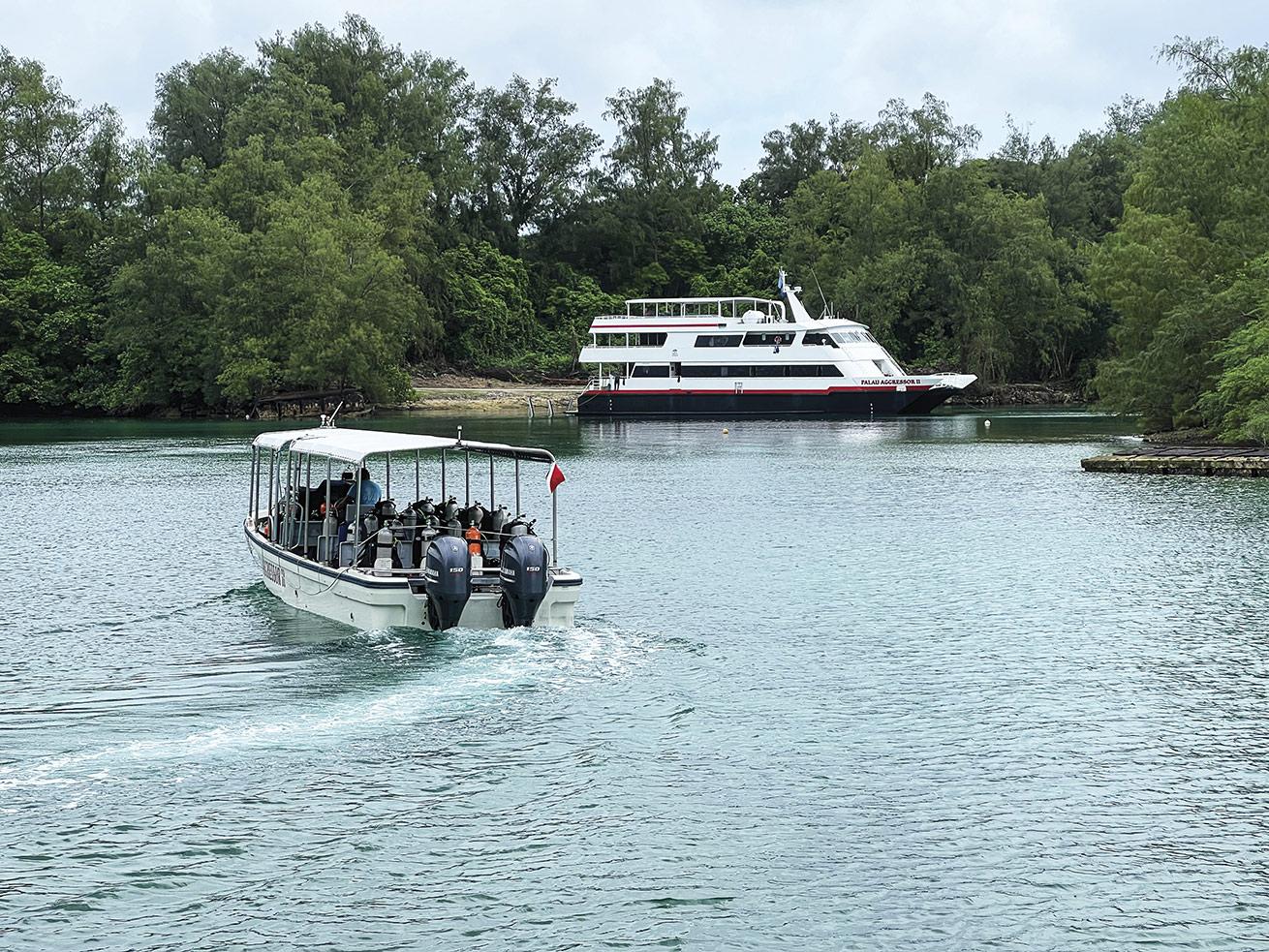
Candice LandauPalau Aggressor II docks at Peleliu Island on Christmas Day. Passengers curious about its wartime past can take the skiff to shore and get an in-depth tour.
“Explosive,” I write after my dive at Turtle Cove. On this dive, I exit the water and remove my mask. As I do, tiny iridescent-red octopuses plop to the deck like beads from a broken necklace.
“Candy!” my guide Ike scolds affectionately. He kneels and starts returning them to the water. One, two, three…I stop counting after the eighth.
My boyfriend tells me I looked as though I were diving inside a living cloud. Sure enough, my rash guard and camera still crawl with plankton—krill, copepods, tiny isopods, and who knows what else.
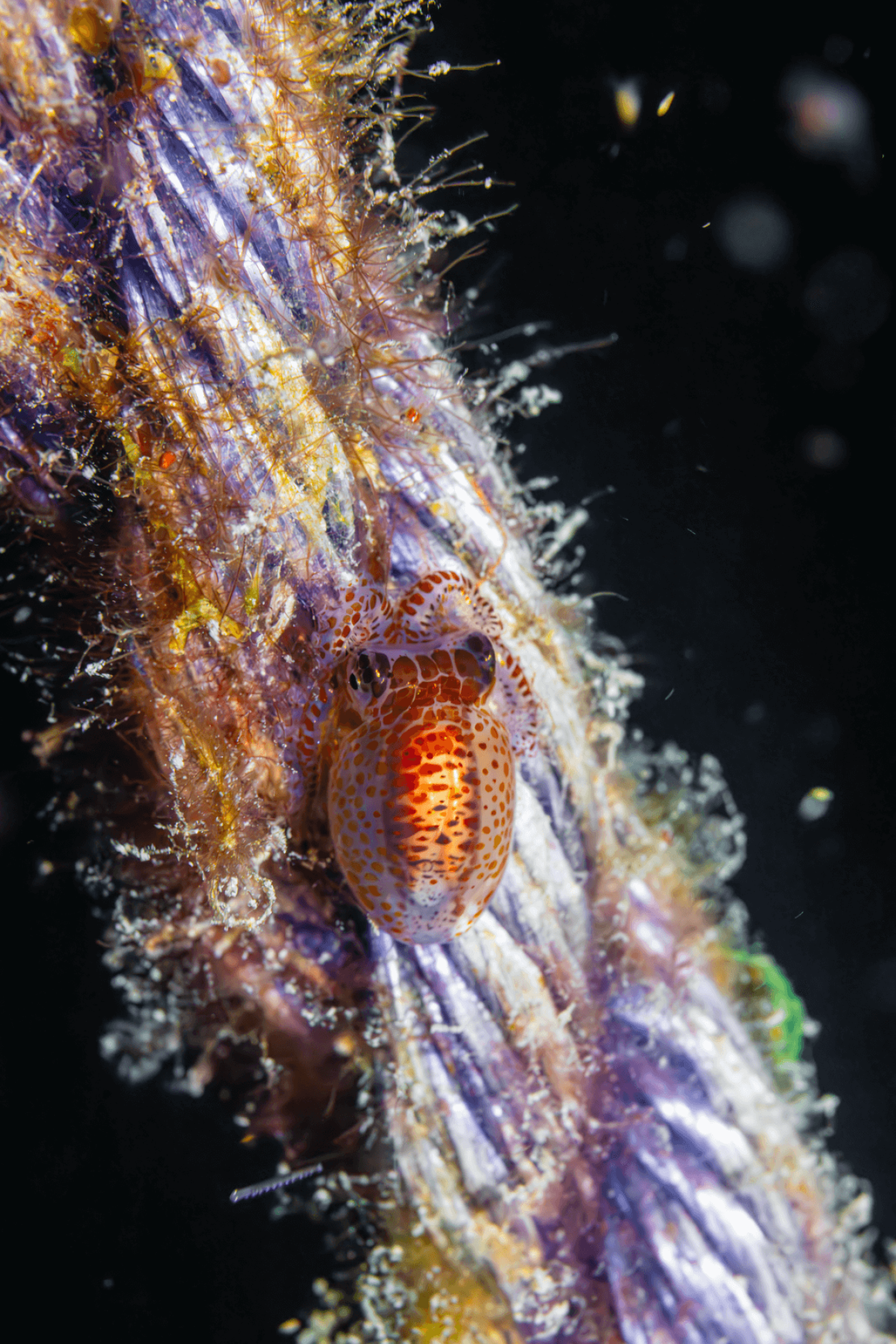
Candice LandauTiny cephalopods like this one are common on night dives.
A Different Kind of Christmas
A month before the trip to Palau, my mother texts.
“Can’t wait to see you, old Canz,” she says. “We can work on our novels together.”
My heart sinks. Though not particularly religious, our family has always spent Christmas together. No matter where we are, my sisters and I fly home. Sometimes it’s a vacation rental on the wild Oregon coast; other times, a house near vineyards outside Portland. It’s become our tradition.
Related Reading: Palau's Enduring Dive Appeal
Overwhelmed with guilt, I tell her Stephen and I won’t be joining this year. Instead, we’ll fly to Palau and spend Christmas on a liveaboard with 16 strangers, likely without internet or cell service.
As excited as I am to dive these distant waters, I wonder why I chose Christmas of all times. It helps to remember that this will be Stephen’s first holiday without his mother, who passed unexpectedly in November. Maybe it’s better for us to be somewhere new, to keep busy, to be distracted by activity. Maybe it will help us heal.
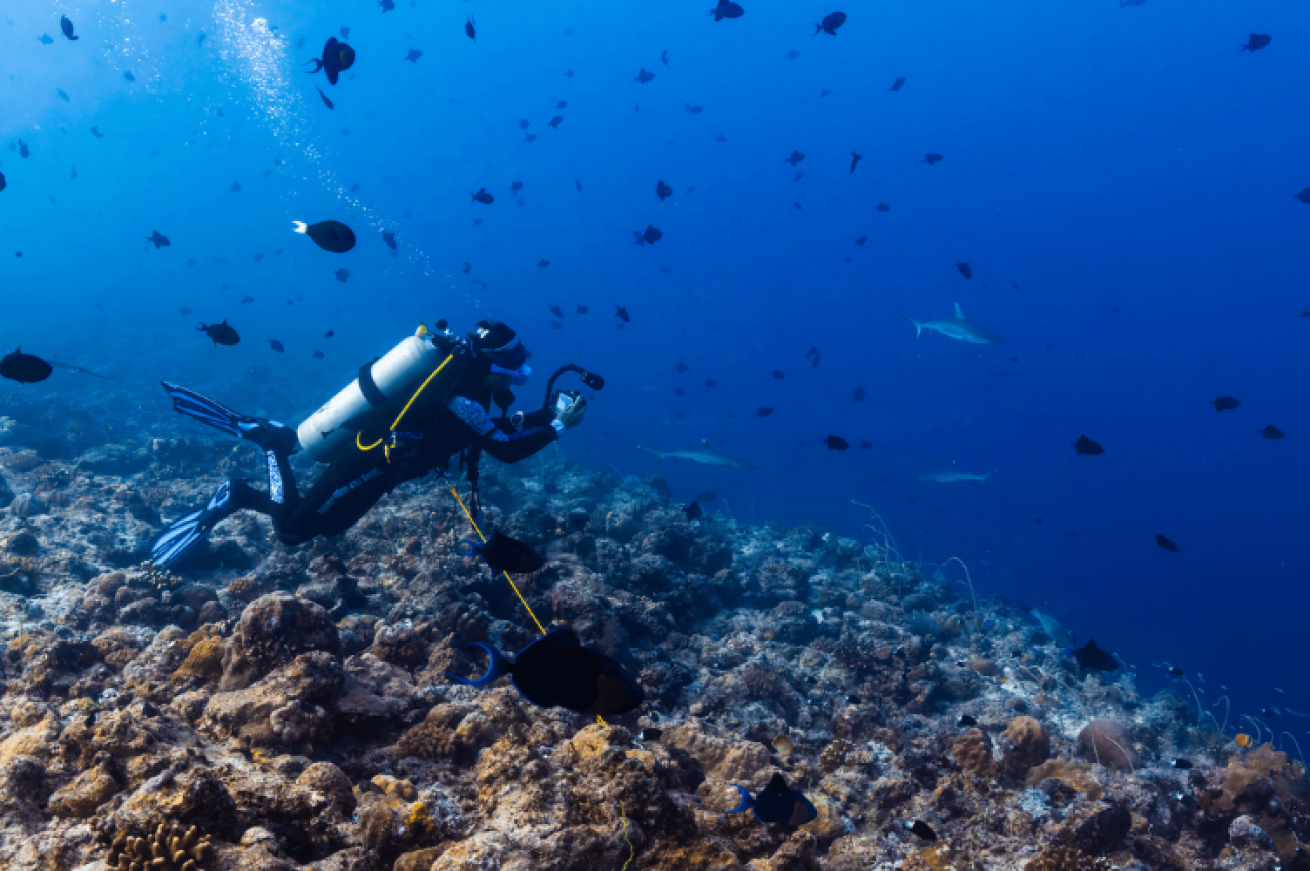
Candice LandauSharks are common at many sites, and divers hook in to the reef to watch them pass.
A Whirlwind Land Tour
When we arrive in Palau, our passports are stamped with the Palau Pledge. It spans a full page and may be the smartest entry stamp I’ve seen: a series of stanzas encouraging visitors to protect Palau, its people and its environment.
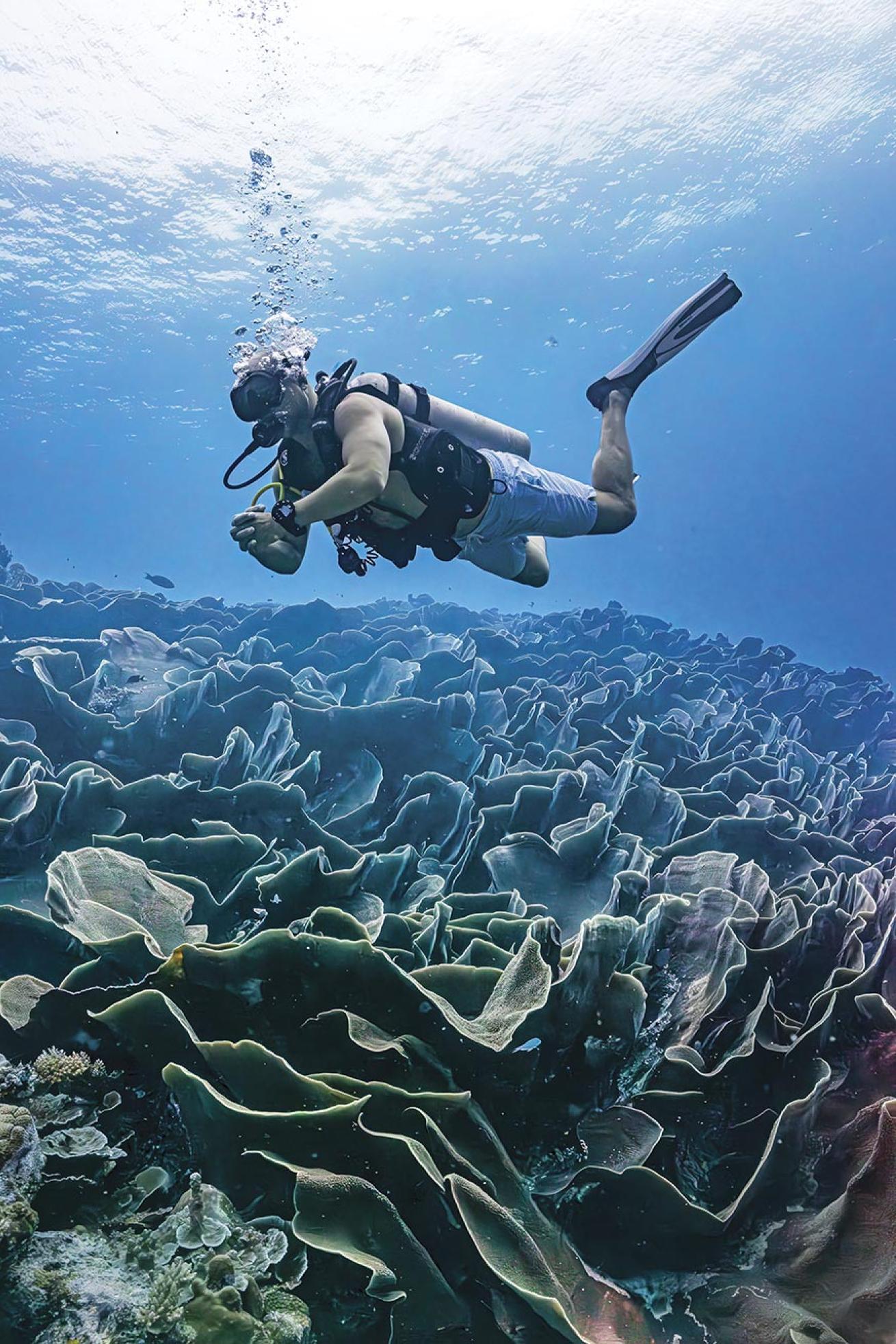
Candice LandauHeath hovers over lettuce coral in Ulong Channel.
Our hotel shuttle weaves from the airport on Babeldaob through the quiet streets of historic Koror on Koror Island, then across the Didall Causeway to Ngerkebesang Island. I’m struck by how wild these islands feel, despite being inhabited since 2500 BC.
From our chalet at Palau Carolines Resort, the view is stunning—coconut palms, lush hills, hibiscus flowers and the ocean. Even in daylight, crickets and frogs are in full chorus, while birds trill nonstop.
To explore Babeldaob, we rent a car. The roads are quiet, speed limits low, and we rely on my fold-out Franko Maps guide for both navigation and history. It leads us to Ngatpang Tabecheding and Ngardmau waterfalls. Though both are beautiful, we joke that Ngardmau should come with a black-diamond warning. It’s a steep hike requiring plenty of water—and a refreshing dip in the pond below.
Driving around Babeldaob takes us an entire day. In addition to our two muddy waterfall treks, we stop to photograph World War II iron ruins and visit the Badrulchau Stone Monoliths, squinting to spot which rocks have faces carved into them.

Candice LandauPalau Aggressor II guest Ken watches a school of glittering fish hover over coral.
The day before we board the boat, we visit Belau National Museum. It’s fascinating, and Stephen and I spend a couple of hours poring over Palau’s history of colonization, its culture and recent archaeological discoveries on Babeldaob.
Outside, a reconstructed bai—a traditional village meeting house—steals the show. Painted bright yellow and adorned with sharks, fish, canoeing figures and other symbols, it underscores how deeply connected this culture is to the ocean. Incense wafts from inside, and I watch as Stephen reads every word on the plaque, completely engrossed.

Candice LandauA peppermint sea star is out for a meal on our night dive at Turtle Cove.
More Than Diving
The liveaboard is decked out in tinsel, baubles and a small Christmas tree near the bar, but the real showstopper is Chef Ramil’s food. On the first day, he fries up turon—Filipino banana rolls that are sweet, crunchy and irresistible. I beg him to make more before the trip ends.
We sleep and dine on the liveaboard but dive from a smaller skiff. Captain Ike runs the mothership while Jake, our skiff captain, bobs to music at the wheel and skillfully navigates the narrow arches and rocky outcroppings of the Rock Islands. It’s hard to decide what to film—the dramatic scenery or Jake’s swinging disco moves.
On Christmas Day, Ike hands each of us a present. It’s a box of Palauan chocolate that tastes like the malty Milo drink of my childhood. Stephen eats most of it, while I—never a sweet tooth—prefer to let curling fumes of coffee bring me back to consciousness.
This morning, we have two options. We can dive, or we can take a tour of Peleliu Island, the site of a major World War II battle between U.S. and Japanese troops. We pick the tour, and Jake ferries us in. We visit an airfield, overgrown tanks, guns high in the hills, and a few bombed buildings, each reclaimed by nature in a haunting yet strangely beautiful way.
Related Reading: Best Destinations for Wall Diving

Candice LandauRemains of a World War II tank on Peleliu Island, the world’s most well-preserved battlefield.
Finally, we venture into the Peleliu caves. Stephen is so tall he’s first to knock his head on the roof and thus first to discover what fellow passenger Jonas tells us are tailless whip scorpions. Thankfully, they don’t sting. I’m relieved to exit the cave after finding a human bone in the midst of a stash of broken sake bottles and half-melted shell casings.
Outside the cave, a small hotel provides internet, and everyone checks in with family. Stephen calls his father. I send WhatsApp messages. My parents and sisters are thrilled to hear from me.
Back on board we savor Ramil’s Christmas sushi lunch before gearing up for our first dive at Orange Beach Coral Garden, a site littered with World War II relics: old Coke bottles, mounds of bullets, artillery shells and the remains of an M18 Hellcat tank, so overgrown with corals and algae it may as well be reef. A giant clam as large as a war chest holds me just as captive, its golden-brown mantle undulating like surface swell.
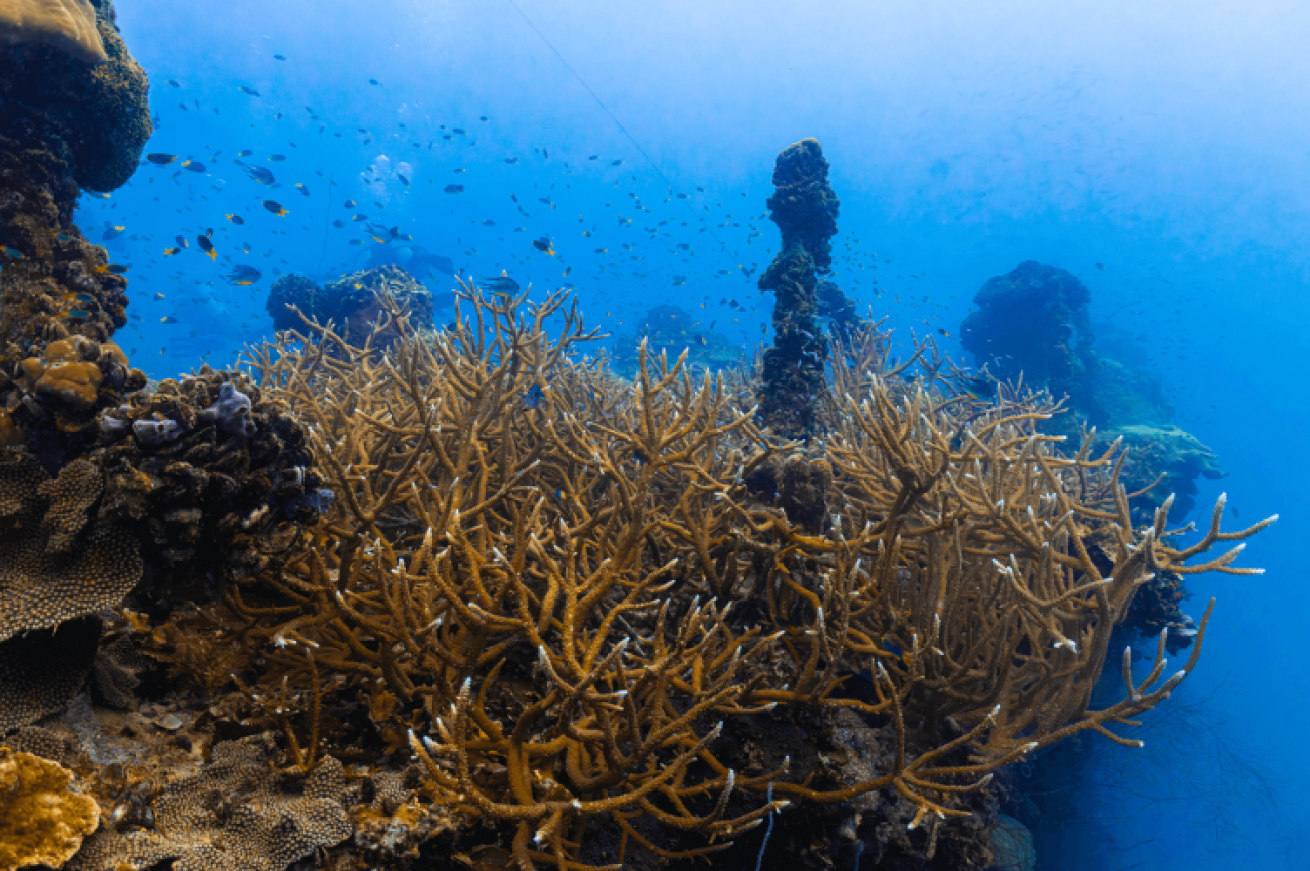
Candice LandauCoral grows thick on the Iro wreck, a World War II fuel supplier.
Magical Memories
Of all the sites we dive, two stand out: Ulong Channel and Sandy Paradise.
Ulong Channel begins as a wall dive. We hook into rocks and watch cigar-shaped sharks glide by. One reef shark has a lead weight dangling from its mouth. It swims closer than the rest. I suspect it wants help, but unsure how to give it safely, I do the only thing I can—I take a photo. My heart aches for it.
After 20 minutes, we unhook and, as a group, drift through the channel. Jonas and his buddy Heath lag behind us, delayed because Jonas is filming a school of barracuda. The barracuda look like models posing for a shoot. Muted sunlight glitters across their silver scales, and they hang motionless as he records.

Candice LandauA small crinoid shrimp sits on a feather star on a night dive.
When the guides warn us to avoid nesting triggerfish, I feel I’m traversing a field of land mines. Their circular sand nests, marked by small coral piles, are fiercely protected territory. I’m more wary of these cat-size fish than I am any shark.
We also see dozens of camouflage grouper bustling across the reef floor. They ignore us completely.
Near the end of the channel, I squeal through my regulator. Stephen turns in alarm, and I gesture ahead to where layer upon layer of lettuce coral rises like a sunken citadel, sprawling and spiraled, rimmed in cappuccino-colored froth. Bream and cardinalfish hover above the blooms, wavering like flags over a city. I motion Stephen into position for a photo, but no image can capture the scale, or the play of light. It’s the largest coral colony I’ve seen in my life.

Candice LandauA reconstructed traditional bai at Belau National Museum in Koror.
At Sandy Paradise, I know we’re in for a treat. It’s a new moon, exactly when bumphead parrotfish spawn. This is a spectacle people travel to witness.
Before we reach the spawning site, our guide Jay-R stops at an unremarkable mound of coral. He points to his mouth and calmly removes his regulator. Two cleaner wrasse dart in. They set about delicately picking his teeth. Intrigued, I take my own regulator out. The wrasse respond immediately. Their tiny mouths bump softly against my gums—piff, piff, piff—quick and deliberate. It’s surreal and oddly intimate, and I can’t help laughing. Stephen, already ahead with our other guide, misses the exchange—he’s primed for the main event.
Sure enough, just beyond the reef, hundreds of bumphead parrotfish hover 50 feet below the surface. In this way, when they spawn, their offspring will be out of reach of any reef predators.
What follows is mesmerizing: a fireworks display underwater. When a female is suitably impressed, she breaks away and zooms toward the surface. Male parrotfish chase her, surging upward in a blur of motion, their gametes trailing behind like streaks of smoke. Then—woosh—they burst apart, leaving a starburst of milky trails in their wake before rejoining the group. It repeats again and again, and each of us is spellbound.
Related Reading: Your Local Dive Shop: A Gateway to Liveaboard Diving
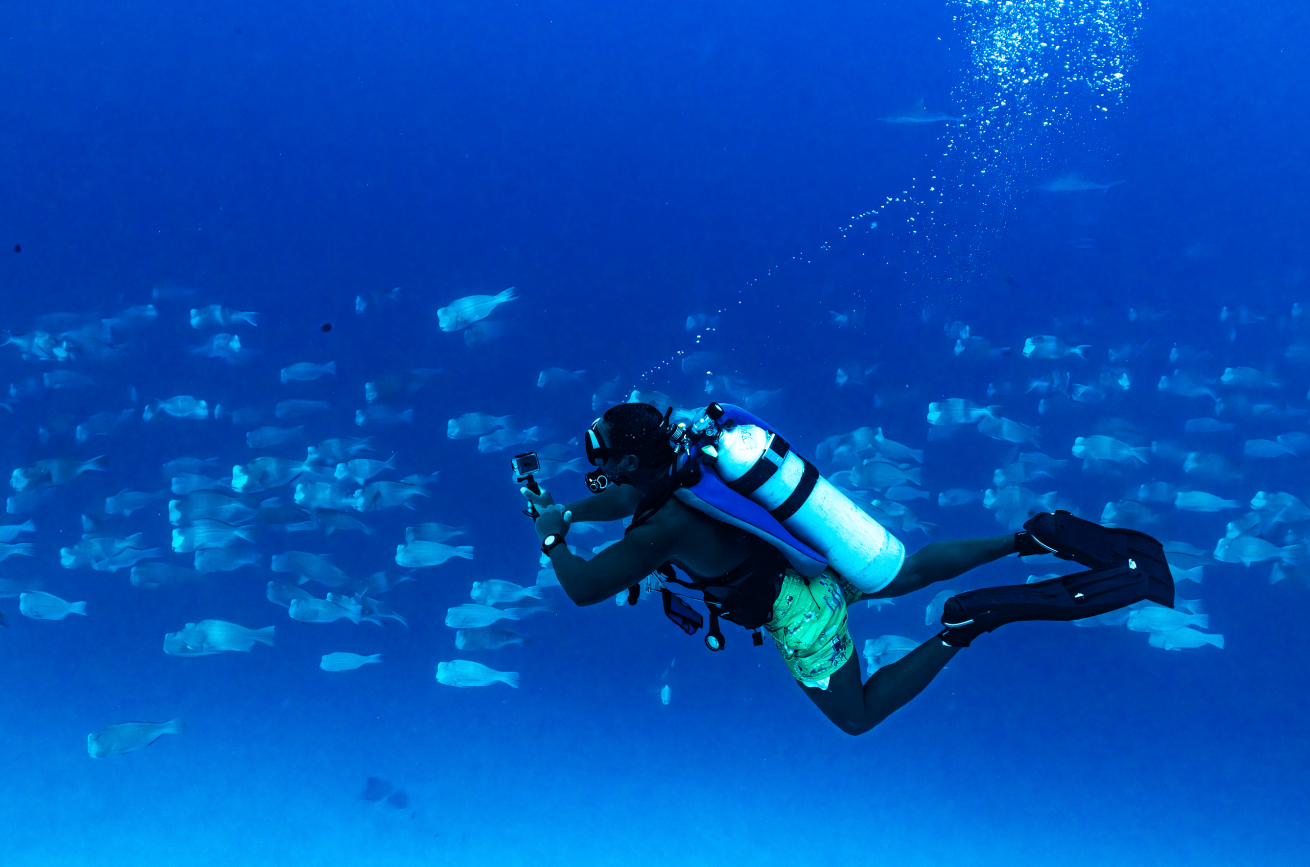
Candice LandauJonas films the bumphead parrotfish spawning.
I turn to look for Stephen and find he’s watching me. He forms a tiny heart with his thumb and fingertip. He doesn’t use this gesture often underwater, but when he does, I know it means so much more than “I love you.” It also says, “I’m happy. I’m present. This is special.”
My eyes blur for a moment as I return it. We might not skip another family Christmas anytime soon, but right now we are creating a few traditions of our own.
Need to Know for Diving in Palau
Operator
Palau Aggressor II (aggressor.com)
Water Temperature
The average water temperature is about 82°F (28°C) year-round.
What to Bring
A rash guard or 3 mm wetsuit is ideal. Consider bringing a marine rescue GPS for safety in the sometimes strong currents. I use a Nautilus LifeLine. Reef Hooks are provided.
When to Go
Palau offers spectacular diving year-round, with seasonal highlights. From December to March, manta ray mating season offers the chance to see 20 to 30 mantas at once. February and March are ideal for spotting large schools of Moorish idols, unicornfish and butterflyfish. Massive baitballs of scad can be seen throughout the year at Ulong Channel, German Channel and Blue Corner.
Cost
Trips aboard Palau Aggressor II start at around $3,735 per person for a seven-night itinerary, including accommodations, meals, diving and airport transfers. Nitrox is available for an additional fee.
Airport
Roman Tmetuchl International Airport (ROR)
Tipping
Tips are not included in the trip price. A gratuity of 10 to 15 percent of the trip cost is customary and can be given in cash or charged to a credit card at the end of the trip.

